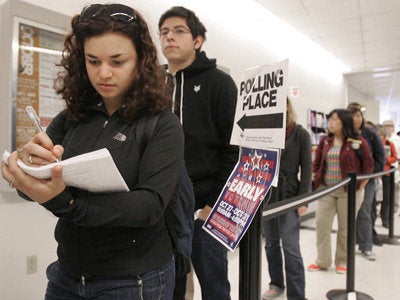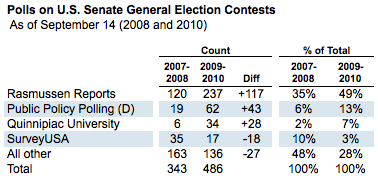
Earlier today, Fox News released five new polls measuring voter preferences in the Senate races in Florida, Nevada, Pennsylvania, Ohio and California. The Fox News story says the polls are conducted by Pulse Opinion Research. We will tackle the results in another article, but for now political junkies may be wondering, what is Pulse Opinion Research?
The answer (as reported earlier today by Political Wire) is that Pulse is a "field service" spun off of of Rasmussen Reports that conducts their well known automated, recorded-voice surveys. It also conducts polls for other clients including, as of today, Fox News. While the questions asked on specific surveys may differ, the underlying methodology used by Fox/Pulse and Rasmussen are essentially identical.
Earlier this year, Rasmussen launched a new website for Pulse that, as he explained to Tim Mak of the Frum Forum, allows anyone to "go to the [Pulse] website, type in their credit card number, and run any poll that they wanted, with any language that they want... In effect, you will be able to do your own poll, and Rasmussen will provide the platform to ensure that the polling includes a representative national sample." According to the Pulse web site, basic election surveys start at $1,500 for a sample of 500 state or local respondents.
Scott Rasmussen confirms, via email, that surveys conducted by Pulse for Fox News and for Rasmussen reports are essentially equivalent in terms of their calling, sampling and weighting procedures:
Pulse Opinion Research does all the field work and processing for Rasmussen Reports polling. They do the same for other clients using the system that I developed over many years. So, in practical terms, polling done by Pulse for any client, including Fox News, will be processed in exactly the same manner. In a Rasmussen Reports poll, Rasmussen Reports provides the questions to Pulse. In a Fox News poll, Fox News provides the questions for their own surveys.
Both will use the same targets for weighting, including weights applied for partisan identification:
The process for selecting Likely Voter targets is based upon partisan trends identified nationally (and reported monthly). In an oversimplified example, if the national trends move one point in favor of the Democrats, the targets for state samples will do the same. As Election Day draws near, the targets are also based upon specific results from all polling done in that state. In competitive states, Pulse can draw upon a large number of interviews to help estimate the partisan mix.
For Election 2010, the net impact is that the samples are typically a few points more favorable to the Republicans than they were in Election 2008. Also, most of the time, the number of unaffiliated voters is a bit lower than in 2008. The samples also show a lower share of minority voters and younger voters.
One positive aspect of the new Fox News/Pulse surveys is that Fox is making demographic cross-tabulations freely available (example here) that Rasmussen Reports keeps behind a subscription wall. And Fox is going a step further, adding weighted sample sizes for each subgroup (something Rasmussen does not currently make available even to subscribers). So if you want to see the demographic composition, you can use the weighted counts to calculate the percentages.
On the other hand, this development may well double the number of polls conducted with the Rasmussen methodology in some races going forward. For example, the Fox/Pulse surveys were conducted on Saturday, September 11 and included samples in Nevada and Ohio. Today, Rasmussen Reports released two additional surveys conducted in Nevada and Ohio on Monday, September 13. Rasmussen, again via email, confirms that his "Rasmussen Reports polling schedule in entirely independent of anything the Fox or Pulse does." He adds:
Our plans were laid out long ago, with the only variable being which races remain the closest as Election Day approaches. For example, we don't expect to poll Connecticut as often as California. But, if the CT race gets closer (as possibly suggested by Quinnipiac), we will poll it more frequently. Same thought process holds true for West Virginia.
As it is, the Rasmussen surveys have already grown far more numerous and dominant so far this election cycle than in 2008. Pollster.com has already tracked 237 Rasmussen Reports surveys on the 2010 elections for U.S. Senate, almost double the number at this point for U.S. Senate races in 2008 (120). While the total number of surveys fielded by all pollsters have also increased, Rasmussen's share of these polls has grown significantly, from 35% of all Senate polls so far to 49%

Rasmussen is the only pollster active in about a half dozen less competitive contests and has fielded three out of four polls in states that have been only marginally competitive, like Indiana and Delaware.
The growing predominance of Rasmussen's surveys so far this cycle has consequences for all that follow and track polling data, including our efforts to track and chart polls at Pollster and Huffington Post. This is another story that we will focus on in the weeks ahead.
